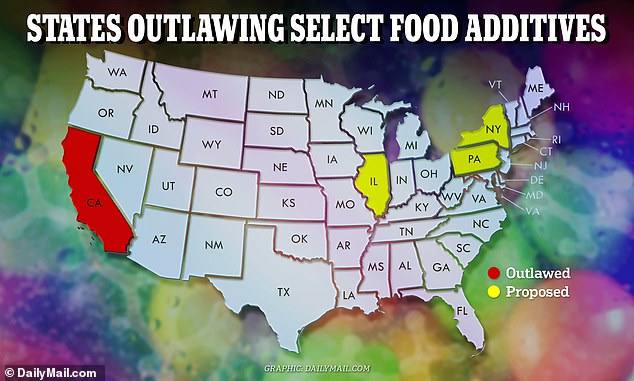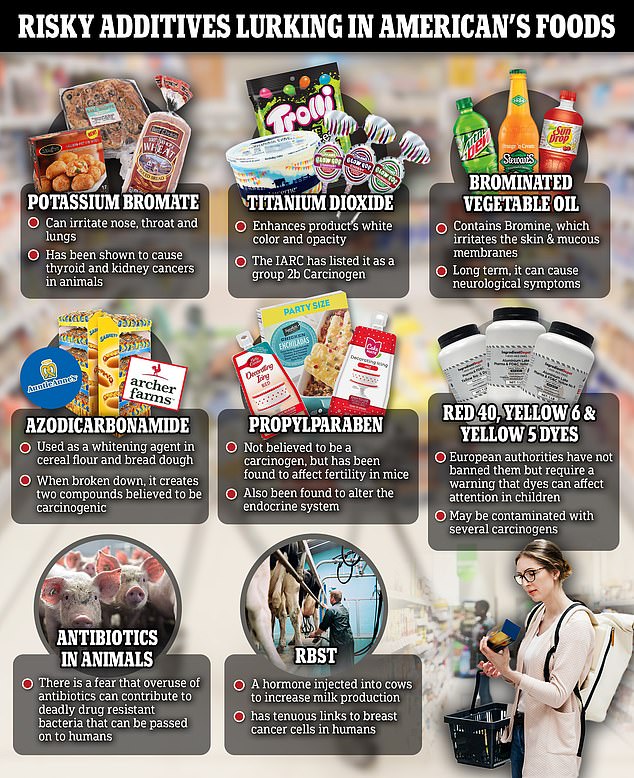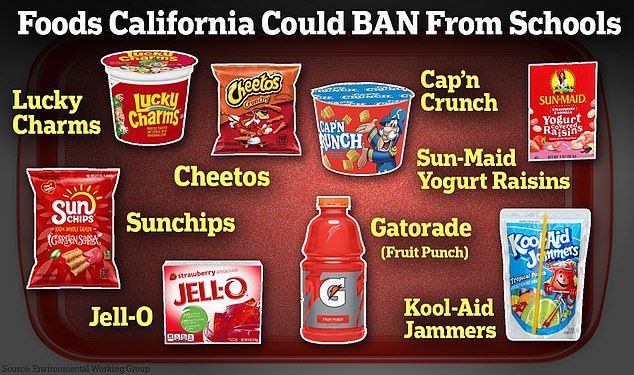Cheetos, Sunchips and some raisins could soon become things of the past in California public schools.
State lawmakers have approved a bill, the first in the nation, that would ban schools from serving food containing six artificial ingredients that have been linked to low IQ, behavioral problems and cancer.
The bill has already been sent to Gov. Gavin Newsom’s desk, which, if signed, would take effect in December 2027.
Supporters of the legislation call it an important step forward in protecting the health of California’s children.
Prohibits foods containing the additives red coloring no. 40, yellow coloring no. 5, yellow coloring no. 6, blue coloring no. 1, blue coloring no. 6, and green coloring no. 3.

The ingredients that could be banned are abundant in ultra-processed foods (UPF) and have been associated with a number of medical problems.
Red 40, as well as Yellow 5 and Yellow 6, contain benzidene, a human and animal carcinogen that is allowed at low, safe levels in dyes and can be found in products like Sour Patch Kids and Lucky Charms.
According to the FDA, ingestion of free benzidine raises the risk of cancer to just below the threshold of “concern,” or one case of cancer per million people.
Consumers can find Red 40 in cake frostings, while those who love baked treats like Twinkies will get a dose of Yellow 5.
Meanwhile, Yellow 6 can be found in sugary breakfast cereals, including Cap’N Crunch.
Red 40 and Yellow 5 have also been linked to hyperactivity in children, raising concerns that they may affect learning and cognitive function, and in turn, IQ.
Both blue dyes 1 and 6 have been linked to hyperactivity in children, as well as allergic reactions.
Some studies also suggest that blue dye 1 may cause cancer or organ damage in high doses.
House Democrat Jesse Gabriel, who led the nation’s first ban on other food additives in California earlier this year, said: “California has a responsibility to protect our students from chemicals that harm children and can interfere with their ability to learn.
‘As a legislator, a parent, and someone who has struggled with ADHD, I find it unacceptable that we allow schools to serve foods with additives that are linked to neurobehavioral harm.
‘This bill will enable schools to better protect the health and well-being of our children and encourage manufacturers to stop using these harmful additives.’
The bill received bipartisan support and was voted on in the Senate on Wednesday with 34 votes in favor and four abstentions.
And on Thursday, the House of Representatives voted on the bill with 70 votes in favor and nine abstentions.
The bill — AB2316 — has also been co-sponsored by watchdog groups the Environmental Working Group (EWG) and Consumer Reports.
Brian Ronholm, director of food policy at Consumer Reports, said: ‘Dangerous dyes that put children at greater risk for hyperactivity and other neurobehavioral problems that hinder learning should not be allowed in foods sold in schools.
‘Banning these harmful dyes in school foods will protect the health and well-being of children in California.’

He added: “Consumer Reports applauds Assemblymember Gabriel for introducing this critical food safety legislation and urges Governor Newsom to sign this bipartisan bill into law.”
The new law would allow California public elementary schools to serve students only fruits, vegetables, dairy products, protein or whole grain foods.
Foods containing additives would be ruled out, as well as those in which more than 35 percent of their total weight comes from sugars.
The ingredients covered by the California bill are more strictly regulated in the EU and several of them are banned in some countries.
Across the EU, authorities require products containing Red 40 to carry a warning label stating: “May have adverse effects on activity and attention in children.”
California leads the nation in bans on food additives, having passed a ban on four cancer-causing food additives in October of last year.
This will ban the sale in the state of products containing brominated vegetable oil, potassium bromate, propylparaben and red dye 3.
It affects about 12,000 products and is expected to go into effect in January 2027, with companies facing fines of up to $10,000 if they are found to be manufacturing, distributing or selling products with those ingredients in the state.
Experts say the ban has the potential to change product recipes across the country because of the size of California’s market, with 40 million people, or 10 percent of the U.S. population.


